From the arrival of the Portuguese colonisers in 1500 to Brazil’s independence, many important events marked the history of Brazil.
These historical events were recorded in the works of painters such as Oscar Pereira da Silva, Victor Meirelles, Jean-Baptiste Debret, Manuel José de Araújo and Pedro Américo.
Main historical events that have marked the history of Brazil are:
1. The landing of Pedro Álvares Cabral in Porto Seguro in 1500
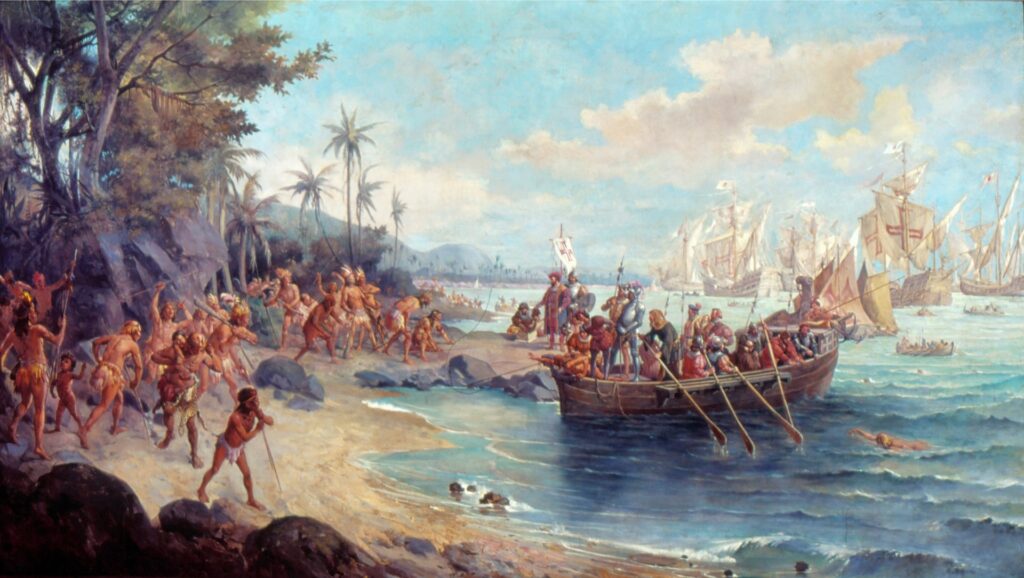
Pedro Álvares Cabral‘s Landing in Porto Seguro in 1500 (sometimes called the Discovery of Brazil) is an oil painting on canvas by Brazilian artist Oscar Pereira da Silva.
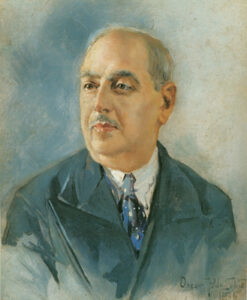
Completed in 1900, this canvas depicts the first landing of Pedro Álvares Cabral’s ships on Brazilian soil, in what was to become Porto Seguro, in the state of Bahia.
Belonging to the genre of history painting, which combines portraiture, still life and landscape to depict a particular event of historical significance, the work was received with great prestige by society and the press of the time, and definitively established Oscar Pereira da Silva as a prominent painter on the national art scene at the beginning of the 20th century.
Pereira da Silva’s painting is one of the most referenced images of the arrival of Pedro Álvares Cabral’s caravans in Brazil, and is the most widely used in textbooks and other academic publications.
2. First Mass in Brazil
The first of Victor Meirelles‘s great compositions, The First Mass in Brazil remains the most famous and significant work of his entire oeuvre.
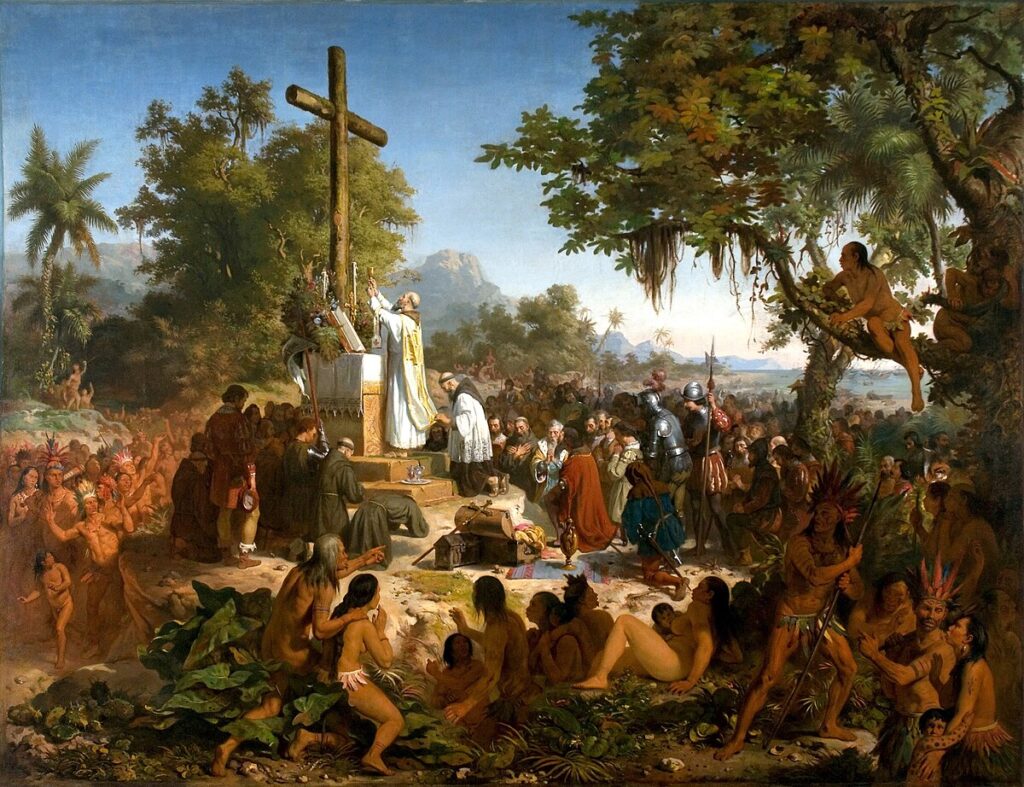
Painted in Paris between 1858 and 1861, during his second period as a scholarship student at the Imperial Academy, it measures 2.70 x 3.57 metres without frame.
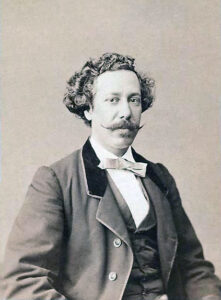
The work won him recognition at the prestigious Paris Salon in 1861 and acclaim in his homeland, where he was decorated as a Knight of the Order of the Rose by King Pedro II.
The work was a direct result of Pedro II’s nationalist, educational and civilising programme, which aimed, among other things, to visually reconstruct key moments in Brazilian history through the visual arts, in order to crystallise a national identity and serve as a calling card to affirm Brazil among the progressive nations of the world.
He was constantly advised by Araújo Porto-Alegre, the director of the Imperial Academy, and Ferdinand Denis, the director of the Sainte-Geneviève Library in Paris, where he researched indigenous iconography, and probably drew inspiration for the central scene from the French painter Horace Vernet’s Première messe en Kabyli (1853) and Marius Granet’s Une messe au Louvre pendant la Terreur (1847).
The painting depicts an event that would have taken place on 26 April 1500, when Pedro Álvares Cabral had a mass celebrated to symbolically mark the Portuguese Crown’s taking possession of Terra de Vera Cruz and the establishment of the Catholic faith.
3. Departure of Estácio de Sá to found the city of São Sebastião do Rio de Janeiro in 1565
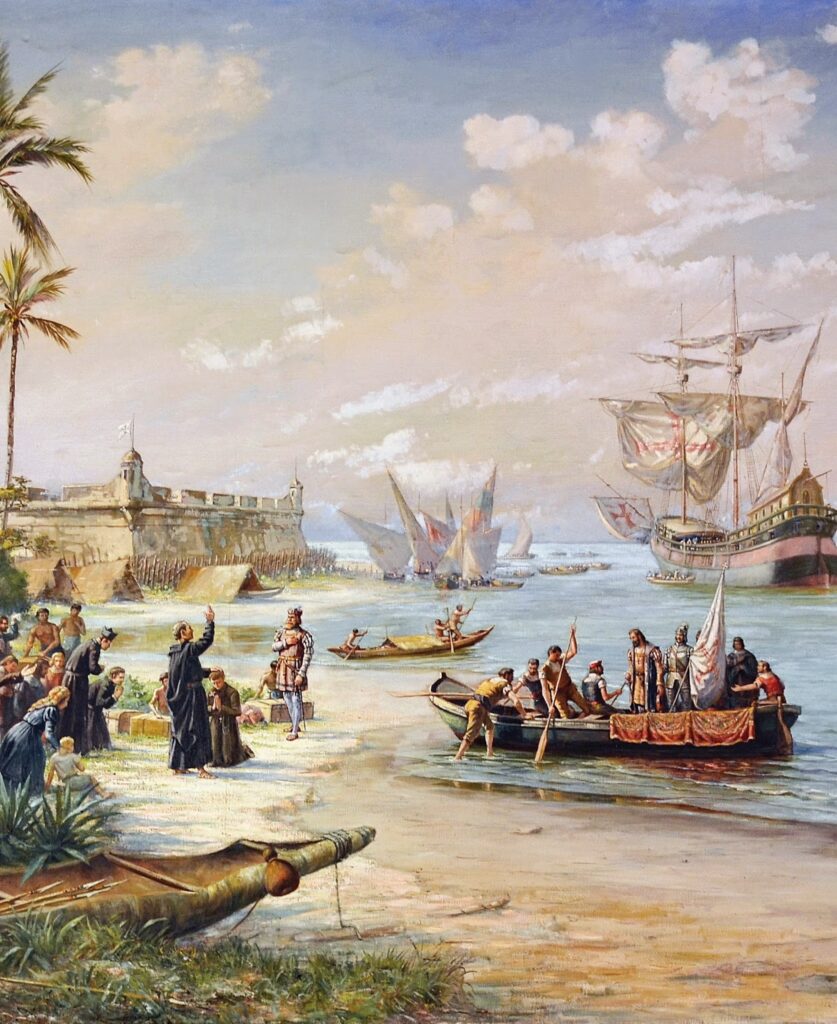
The departure of Estácio de Sá from Bertioga, under the command of São Vicente, towards Guanabara Bay, to found the city of São Sebastião do Rio de Janeiro. Kneeling on the sand, Anchieta receives the blessing of Manuel da Nóbrega. Oil on canvas by Benedito Calixto (1853-1927).
4. Foundation of Rio de Janeiro 1565
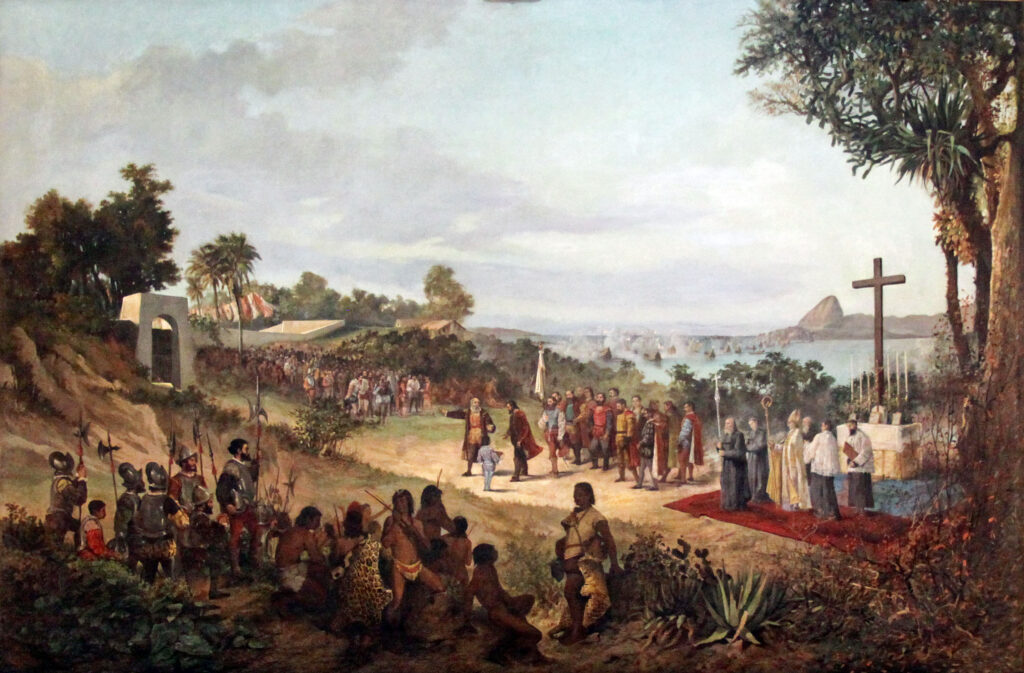
“Foundation of Rio de Janeiro, Mem de Sá handing over the keys of the city to the mayor. Work by Antonio Firmino Monteiro.
5. Attack of Salvador

Attack of Salvador, canvas by the Flemish painter Andries van Eertvelt, c.1624 (probably based on an engraving by Claes Jansz Visscher, also the author of the engraving below with Diogo Furtado), in the collection of the National Maritime Museum, Greenwich. It shows the naval battle in the Bay of All Saints to take the city. Dutchman Piet Hein’s ship is on the bottom right.
6. Punishment of the slaves

The work of Jean-Baptiste Debret is considered a major contribution to Brazil, and is often analysed by

Debret’s work is considered by historians to be a representation of everyday life and society in Brazil – especially in Rio de Janeiro – in the mid-19th century.
Jean-Baptiste Debret was part of the French artistic mission (1817) that founded an academy of arts and crafts in Rio de Janeiro, which later became the Imperial Academy of Fine Arts, where he taught.
Back in France (1831), he published Viagem Pitoresca e Histórica ao Brasil (1834-1839), documenting aspects of Brazilian nature, man and society at the beginning of the 19th century.
7. The Coronation of Dom Pedro II
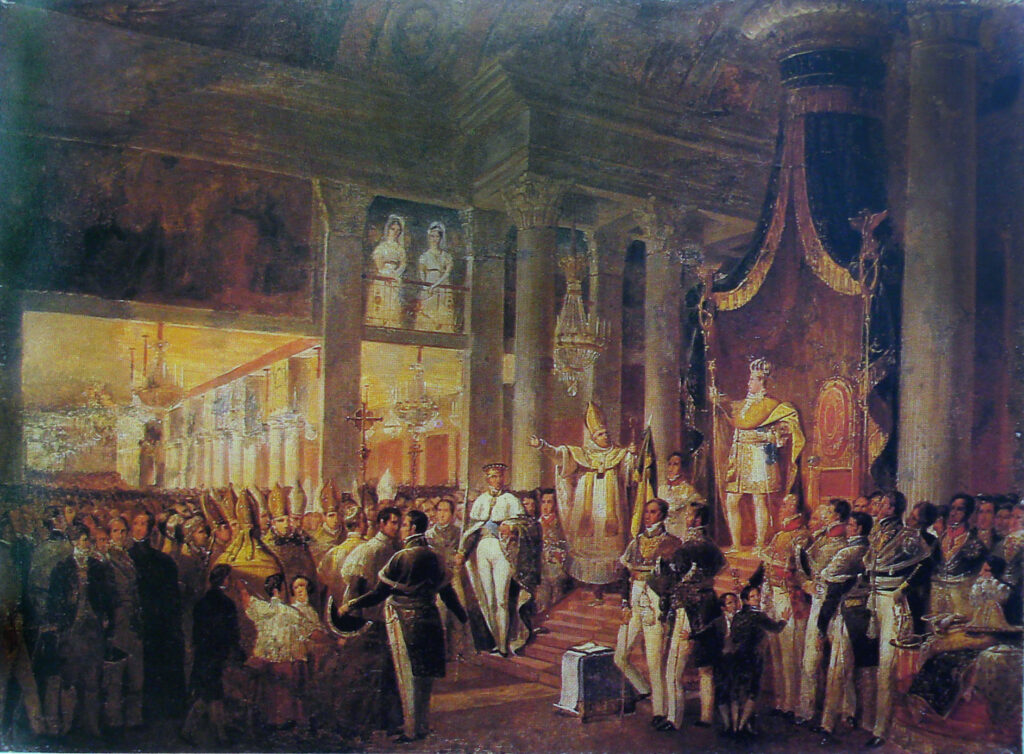
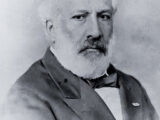
The painting The Coronation of King Pedro II is an oil on canvas dating from 1845 and 1846, measuring approximately 80 x 110 cm.
The work is currently in the National Historical Museum in Rio de Janeiro.
The work was painted by the Brazilian Romantic writer, politician, journalist, caricaturist, architect, teacher and diplomat Manuel José de Araújo Porto-Alegre, the first and only Baron of Santo Ângelo (Rio Pardo, 29 November 1806 – Lisbon, 30 December 1879).
8. The Cry of Ipiranga
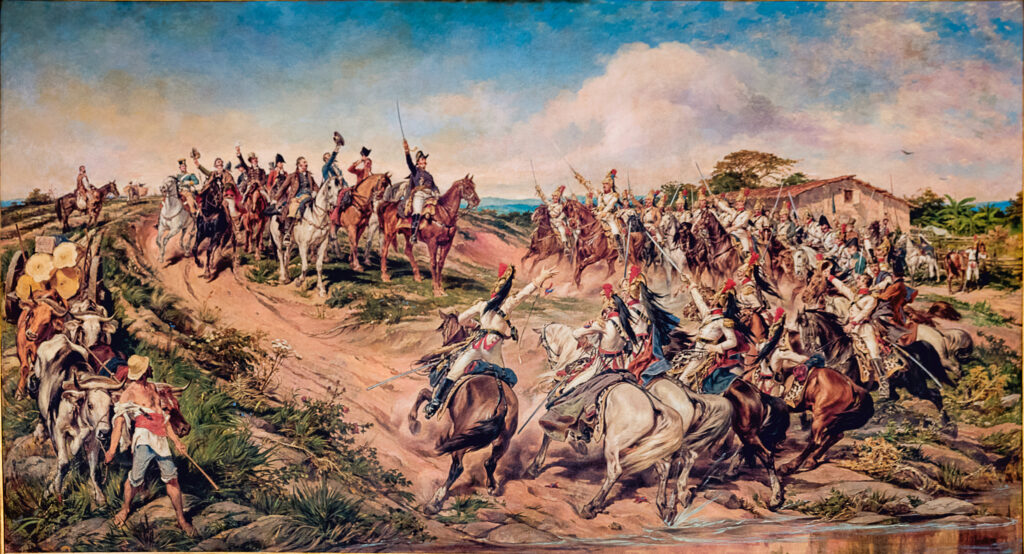
“O Grito do Ipiranga” (The Cry of Ipiranga), also known as “Independence or Death”, is the most famous painting depicting the proclamation of Brazil’s separation from Portugal.
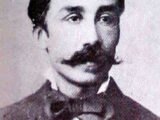
The painting was commissioned in 1886 by the Ipiranga Monument Commission to the painter Pedro Américo, who was also responsible for other important historical paintings such as “The Battle of Avahy” and “Tiradentes quartered”.
The painter carried out meticulous historical research into the independence movement, period costumes and paintings of historical events by other artists.
The canvas was the main work exhibited at the inauguration of the Museu Paulista on 7 September 1895, and was the centrepiece of the building’s main hall.
9. Emperor Pedro II, his wife Teresa Cristina and their daughters, Princesses Isabel and Leopoldina
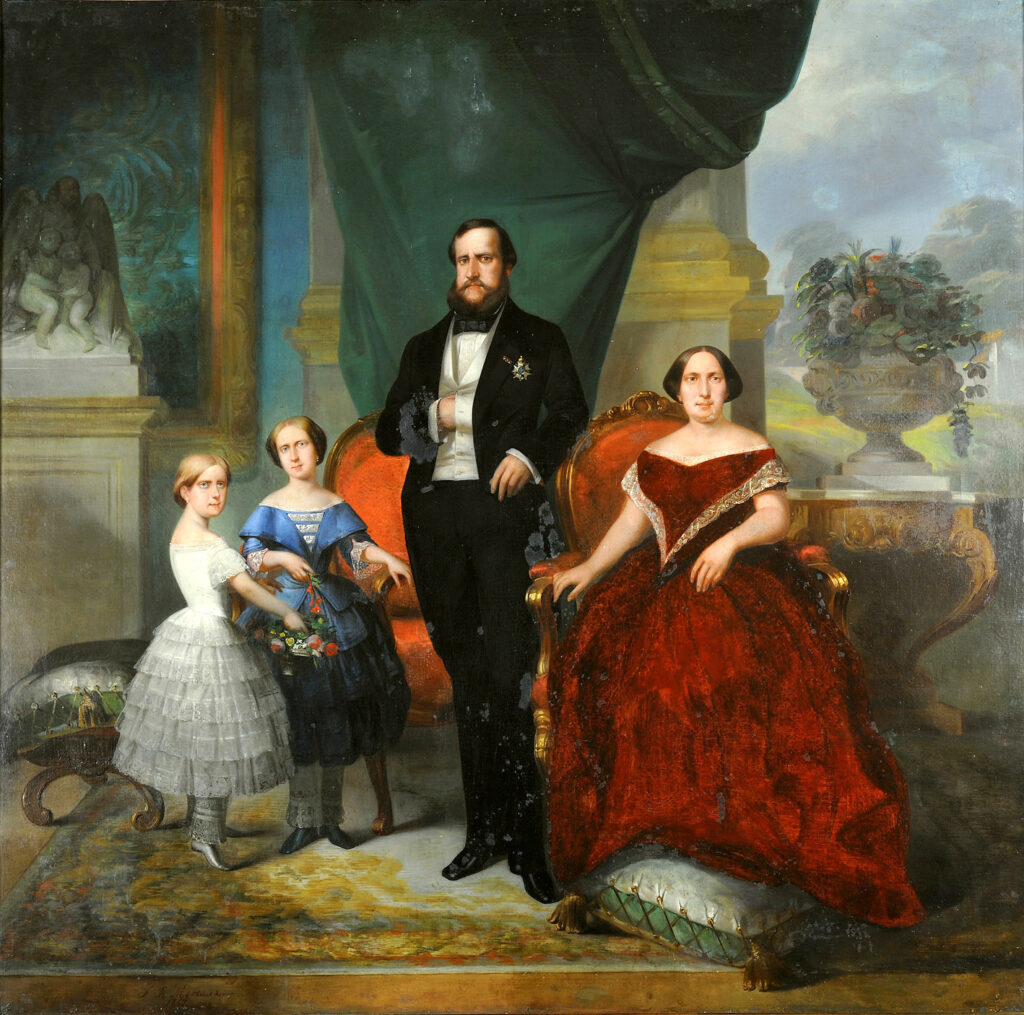
While still in France, the painter François-René Moreaux studied under Couvelet and the Baron de Gross. From 1838 he travelled through Brazil, later settling in Rio de Janeiro.
He taught in his studio and worked as a caricaturist. In 1856 he co-founded the Liceu de Artes e Ofícios, which he also directed and where he taught drawing. The following year, together with Heaton and Regensburg, he founded the Contemporary Brazilian Gallery.
He devoted himself mainly to portraiture, but also to historical painting. He was decorated with the Order of Christ for his painting The Sagration of Dom Pedro II. He exhibited in the halls of the Academy until 1850, and again in 1859. He left portraits of various personalities of the time.
10. The proclamation of independence by François-René Moreaux
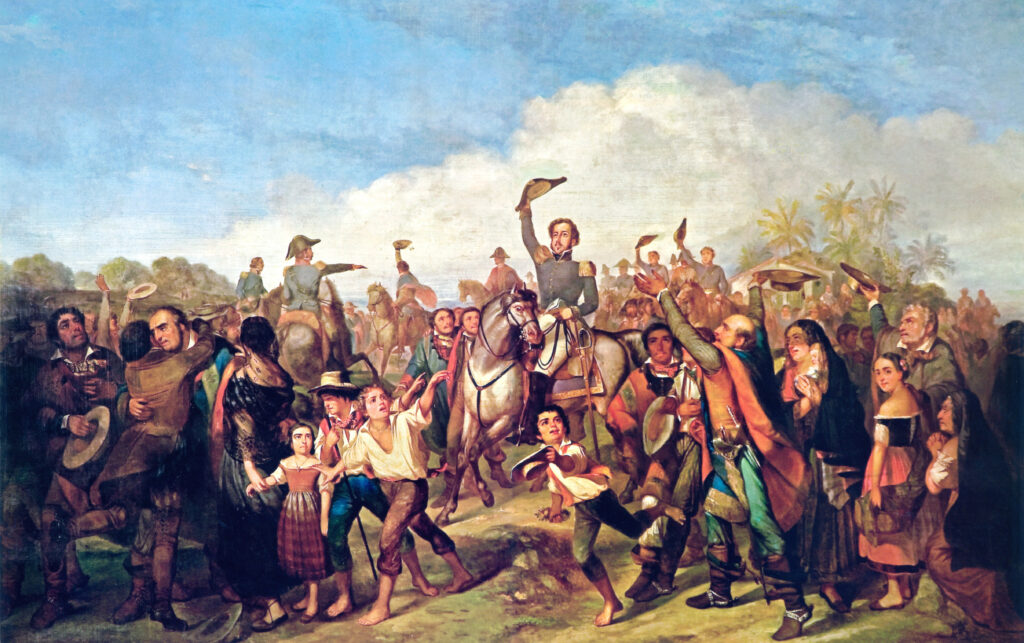
Detail of an oil painting of Brazil’s independence by François-René Moreaux, a French painter living in Rio at the time, now in the Imperial Museum in Petrópolis/RJ.
It was painted in 1844 at the request of the Imperial Senate. This painting predates Pedro Américo’s and may have inspired him.
Brazil’s independence is an extremely important historical milestone for the country. On 7 September 1822, Brazil declared its independence from Portugal, ending centuries of colonial rule.
This emblematic event not only defined Brazil’s political and social trajectory, but also shaped its national identity and laid the foundations for building a sovereign nation.
Publicações Relacionadas
Candomblé in Bahia, Origin and Religiosity of the Bahian People
Colours of houses and buildings in the colonial architecture of the northeast
History of the 8-bass accordion and its influence on forró
History and Chronology of the Carnival of Salvador de Bahia
Monte Santo in Bahia: History and Religious Tourism
Origin of Umbanda: Discover the History of this Brazilian Religion
The Baianas' costume is influenced by African culture
The culture of Northeastern Brazil: how it originated, influenced and flourished
Northeastern architecture marked by typical features of colonial structures
June festivals: Tradition and Culture in the Northeast of Brazil
Unveiling the Myth: Lampião and the Reality of Cangaço
Franciscans in Brazil: Urban, architectural and artistic heritage
Popular Art from the Northeast of Brazil
King Momo, Pierro, Harlequin and Colombina - Carnival characters
Musical styles, rhythms, singers and composers of northeastern Brazil
Turban is Religion, Fashion and Culture in Brazil and the World
Bobbin lace and embroidery: predominant handicrafts in Ceará
History of Baroque Architecture in the Northeast and Minas Gerais
This post is also on:
![]() Português
Português ![]() English
English ![]() Deutsch
Deutsch ![]() Español
Español ![]() Français
Français



















